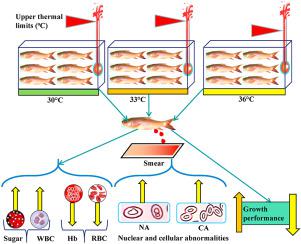当前位置:
X-MOL 学术
›
J. Therm. Biol.
›
论文详情
Our official English website, www.x-mol.net, welcomes your
feedback! (Note: you will need to create a separate account there.)
High temperature acclimation alters upper thermal limits and growth performance of Indian major carp, rohu, Labeo rohita (Hamilton, 1822)
Journal of Thermal Biology ( IF 2.9 ) Pub Date : 2020-10-01 , DOI: 10.1016/j.jtherbio.2020.102738 Mohammad Ashaf-Ud-Doulah 1 , Abdullah Al Mamun 1 , Mohammad Lutfar Rahman 1 , S M Majharul Islam 1 , Rayeda Jannat 1 , Mostafa Ali Reza Hossain 2 , Md Shahjahan 1
Journal of Thermal Biology ( IF 2.9 ) Pub Date : 2020-10-01 , DOI: 10.1016/j.jtherbio.2020.102738 Mohammad Ashaf-Ud-Doulah 1 , Abdullah Al Mamun 1 , Mohammad Lutfar Rahman 1 , S M Majharul Islam 1 , Rayeda Jannat 1 , Mostafa Ali Reza Hossain 2 , Md Shahjahan 1
Affiliation

|
Increase in water temperature due to anthropogenic and climatic changes is expected to affect physiological functions of fish. In this study, we determined high temperature tolerance (CTmax) of a common aquacultured Indian major carp, rohu, Labeo rohita fingerlings (15.96 ± 0.72 g BW, 11.56 ± 0.42 cm TL) followed by acclimatization at three temperatures (30, 33, 36 °C). To determine the CTmax, we analyzed the major hemato-biochemical indices - hemoglobin (Hb), red blood cell (RBC), white blood cell (WBC), blood glucose levels, and erythrocytic nuclear abnormalities (ENAs) and erythrocytic cellular abnormalities (ECAs) of peripheral erythrocytes in the fish sampled at the start and end point at each acclimated temperature. Significantly decreased CTmax of the fish was found at 36 °C compared to 30 °C and 33 °C. The fish in the highest (36 °C) temperature were found with significantly lower Hb and RBC content and significantly higher WBC and blood glucose levels than that of the fishes in the lowest (30 °C) temperature both at the start and end points. The highest frequencies of ENAs and ECAs were found in the highest (36 °C) temperature group compared to the lowest (30 °C) temperature group at both the points. We also evaluated growth performance of the rohu fingerlings reared in the three temperatures for 60 days. The growth parameters - final weight gain, percent weight gain and specific growth rate were the highest at 33 °C and the lowest at 36 °C. The present study revealed that the highest temperature (36 °C) tested here may be hazardous to rohu and the temperature should be kept below 36 °C in the aquaculture setting to avoid physiological damage and growth and production loss to the fish.
中文翻译:

高温驯化改变了印度主要鲤鱼、罗湖、Labeo rohita 的温度上限和生长性能(汉密尔顿,1822 年)
由于人为和气候变化引起的水温升高预计会影响鱼类的生理功能。在本研究中,我们确定了一种常见水产养殖的印度主要鲤鱼、罗湖、Labeo rohita 鱼种(15.96 ± 0.72 g BW,11.56 ± 0.42 cm TL)的高温耐受性(CTmax),然后在三个温度(30、33、36 ℃)。为了确定 CTmax,我们分析了主要的血液生化指标 - 血红蛋白 (Hb)、红细胞 (RBC)、白细胞 (WBC)、血糖水平以及红细胞核异常 (ENA) 和红细胞异常 (ECA) ) 在每个适应温度的起点和终点采样的鱼的外周红细胞。与 30 °C 和 33 °C 相比,在 36 °C 下发现鱼的 CTmax 显着降低。与最低温度(30°C)的鱼相比,最高温度(36°C)的鱼在起点和终点的 Hb 和 RBC 含量显着降低,白细胞和血糖水平显着升高。在这两个点上,与最低 (30 °C) 温度组相比,最高 (36 °C) 温度组中 ENA 和 ECA 的频率最高。我们还评估了在三种温度下饲养 60 天的罗狐鱼种的生长性能。生长参数——最终增重、增重百分比和比生长速率在 33°C 时最高,在 36°C 时最低。
更新日期:2020-10-01
中文翻译:

高温驯化改变了印度主要鲤鱼、罗湖、Labeo rohita 的温度上限和生长性能(汉密尔顿,1822 年)
由于人为和气候变化引起的水温升高预计会影响鱼类的生理功能。在本研究中,我们确定了一种常见水产养殖的印度主要鲤鱼、罗湖、Labeo rohita 鱼种(15.96 ± 0.72 g BW,11.56 ± 0.42 cm TL)的高温耐受性(CTmax),然后在三个温度(30、33、36 ℃)。为了确定 CTmax,我们分析了主要的血液生化指标 - 血红蛋白 (Hb)、红细胞 (RBC)、白细胞 (WBC)、血糖水平以及红细胞核异常 (ENA) 和红细胞异常 (ECA) ) 在每个适应温度的起点和终点采样的鱼的外周红细胞。与 30 °C 和 33 °C 相比,在 36 °C 下发现鱼的 CTmax 显着降低。与最低温度(30°C)的鱼相比,最高温度(36°C)的鱼在起点和终点的 Hb 和 RBC 含量显着降低,白细胞和血糖水平显着升高。在这两个点上,与最低 (30 °C) 温度组相比,最高 (36 °C) 温度组中 ENA 和 ECA 的频率最高。我们还评估了在三种温度下饲养 60 天的罗狐鱼种的生长性能。生长参数——最终增重、增重百分比和比生长速率在 33°C 时最高,在 36°C 时最低。











































 京公网安备 11010802027423号
京公网安备 11010802027423号